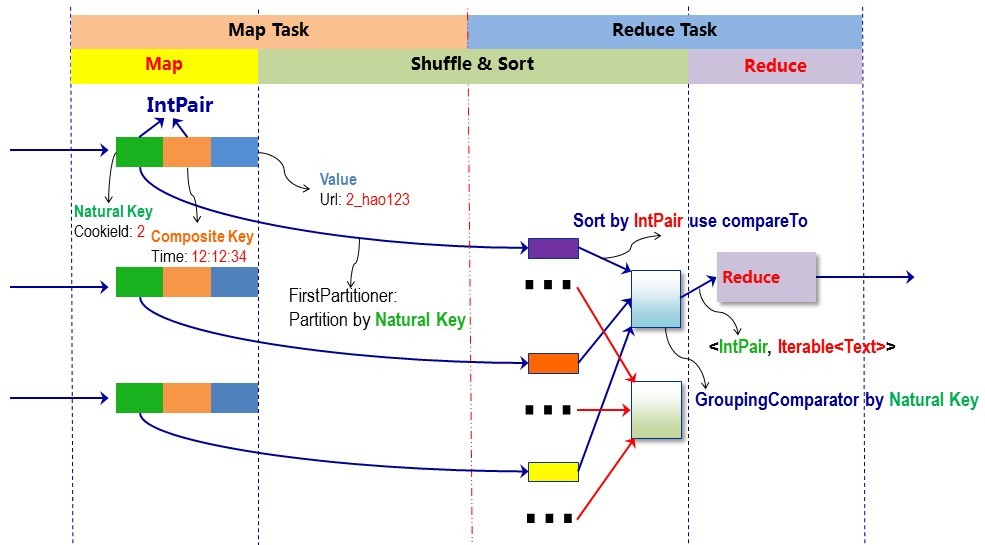转自: http://www.see-source.com/blog/300000028/389
关于二次排序主要涉及到这么几个东西:
在0.20.0 以前使用的是
setPartitionerClass
setOutputkeyComparatorClass
setOutputValueGroupingComparator
在0.20.0以后使用是
job.setPartitionerClass(Partitioner p);
job.setSortComparatorClass(RawComparator c);
job.setGroupingComparatorClass(RawComparator c);
下面的例子里面只用到了 setGroupingComparatorClass
mr自带的例子中的源码SecondarySort,我重新写了一下,基本没变。
这个例子中定义的map和reduce如下,关键是它对输入输出类型的定义:(java泛型编程)
public static class Map extends Mapper<LongWritable, Text, IntPair, IntWritable>
public static class Reduce extends Reducer<IntPair, NullWritable, IntWritable, IntWritable>
1、首先说一下工作原理:
在map阶段,使用job.setInputFormatClass定义的InputFormat将输入的数据集分割成小数据块splites,同时InputFormat提供一个RecordReder的实现。本例子中使用的是TextInputFormat,他提供的RecordReder会将文本的字节偏移量作为key,这一行的文本作为value。这就是自定义Map的输入是<LongWritable, Text>的原因。然后调用自定义Map的map方法,将一个个<LongWritable, Text>对输入给Map的map方法。注意输出应该符合自定义Map中定义的输出<IntPair, IntWritable>。最终是生成一个List<IntPair, IntWritable>。在map阶段的最后,会先调用job.setPartitionerClass对这个List进行分区,每个分区映射到一个reducer。每个分区内又调用job.setSortComparatorClass设置的key比较函数类排序。可以看到,这本身就是一个二次排序。如果没有通过job.setSortComparatorClass设置key比较函数类,则使用key的实现的compareTo方法。在第一个例子中,使用了IntPair实现的compareTo方法,而在下一个例子中,专门定义了key比较函数类。
在reduce阶段,reducer接收到所有映射到这个reducer的map输出后,也是会调用job.setSortComparatorClass设置的key比较函数类对所有数据对排序。然后开始构造一个key对应的value迭代器。这时就要用到分组,使用jobjob.setGroupingComparatorClass设置的分组函数类。只要这个比较器比较的两个key相同,他们就属于同一个组,它们的value放在一个value迭代器,而这个迭代器的key使用属于同一个组的所有key的第一个key。最后就是进入Reducer的reduce方法,reduce方法的输入是所有的(key和它的value迭代器)。同样注意输入与输出的类型必须与自定义的Reducer中声明的一致。
2、二次排序 就是首先按照第一字段排序,然后再对第一字段相同的行按照第二字段排序,注意不能破坏第一次排序 的结果 。例如 :
echo "3 b
1 c
2 a
1 d
3 a"|sort -k1 -k2
1 c
1 d
2 a
3 a
3 b
1 自定义key。
在mr中,所有的key是需要被比较和排序的,并且是二次,先根据partitione,再根据大小。而本例中也是要比较两次。先按照第一字段排序,然后再对第一字段相同的按照第二字段排序。根据这一点,我们可以构造一个复合类IntPair,他有两个字段,先利用分区对第一字段排序,再利用分区内的比较对第二字段排序。
所有自定义的key应该实现接口WritableComparable,因为是可序列的并且可比较的。并重载方法
//反序列化,从流中的二进制转换成IntPair
public void readFields(DataInput in) throws IOException
//序列化,将IntPair转化成使用流传送的二进制
public void write(DataOutput out)
//key的比较
public int compareTo(IntPair o)
另外新定义的类应该重写的两个方法
//The hashCode() method is used by the HashPartitioner (the default partitioner in MapReduce)
public int hashCode()
public boolean equals(Object right)
2 由于key是自定义的,所以还需要自定义一下类:
2.1 分区函数类。这是key的第一次比较。
public static class FirstPartitioner extends Partitioner<IntPair,IntWritable>
在job中设置使用setPartitionerClasss
2.2 key比较函数类。这是key的第二次比较。这是一个比较器,需要继承WritableComparator。
public static class KeyComparator extends WritableComparator
必须有一个构造函数,并且重载 public int compare(WritableComparable w1, WritableComparable w2)
另一种方法是 实现接口RawComparator。
在job中设置使用setSortComparatorClass。
2.3 分组函数类。在reduce阶段,构造一个key对应的value迭代器的时候,只要first相同就属于同一个组,放在一个value迭代器。这是一个比较器,需要继承WritableComparator。
public static class GroupingComparator extends WritableComparator
同key比较函数类,必须有一个构造函数,并且重载 public int compare(WritableComparable w1, WritableComparable w2)
同key比较函数类,分组函数类另一种方法是实现接口RawComparator。
在job中设置使用setGroupingComparatorClass。
另外注意的是,如果reduce的输入与输出不是同一种类型,则不要定义Combiner也使用reduce,因为Combiner的输出是reduce的输入。除非重新定义一个Combiner。
4 代码。这个例子中没有使用key比较函数类,而是使用key的实现的compareTo方法:
001.
package SecondarySort;
002.
003.
import java.io.DataInput;
004.
import java.io.DataOutput;
005.
import java.io.IOException;
006.
import org.apache.hadoop.conf.Configuration;
007.
import org.apache.hadoop.fs.FileSystem;
008.
import org.apache.hadoop.fs.Path;
009.
import org.apache.hadoop.io.LongWritable;
010.
import org.apache.hadoop.io.Text;
011.
import org.apache.hadoop.io.WritableComparable;
012.
import org.apache.hadoop.io.WritableComparator;
013.
import org.apache.hadoop.mapreduce.Job;
014.
import org.apache.hadoop.mapreduce.Mapper;
015.
import org.apache.hadoop.mapreduce.Partitioner;
016.
import org.apache.hadoop.mapreduce.Reducer;
017.
import org.apache.hadoop.mapreduce.lib.input.FileInputFormat;
018.
import org.apache.hadoop.mapreduce.lib.input.TextInputFormat;
019.
import org.apache.hadoop.mapreduce.lib.output.FileOutputFormat;
020.
import org.apache.hadoop.mapreduce.lib.output.TextOutputFormat;
021.
022.
public class SecondarySort
023.
{
024.
//自己定义的key类应该实现WritableComparable接口
025.
public static class IntPair implements WritableComparable<IntPair>
026.
{
027.
String first;
028.
String second;
029.
/**
030.
* Set the left and right values.
031.
*/
032.
public void set(String left, String right)
033.
{
034.
first = left;
035.
second = right;
036.
}
037.
public String getFirst()
038.
{
039.
return first;
040.
}
041.
public String getSecond()
042.
{
043.
return second;
044.
}
045.
//反序列化,从流中的二进制转换成IntPair
046.
public void readFields(DataInput in) throws IOException
047.
{
048.
first = in.readUTF();
049.
second = in.readUTF();
050.
}
051.
//序列化,将IntPair转化成使用流传送的二进制
052.
public void write(DataOutput out) throws IOException
053.
{
054.
out.writeUTF(first);
055.
out.writeUTF(second);
056.
}
057.
//重载 compareTo 方法,进行组合键 key 的比较,该过程是默认行为。
058.
//分组后的二次排序会隐式调用该方法。
059.
public int compareTo(IntPair o)
060.
{
061.
if (!first.equals(o.first) )
062.
{
063.
return first.compareTo(o.first);
064.
}
065.
else if (!second.equals(o.second))
066.
{
067.
return second.compareTo(o.second);
068.
}
069.
else
070.
{
071.
return 0;
072.
}
073.
}
074.
075.
//新定义类应该重写的两个方法
076.
//The hashCode() method is used by the HashPartitioner (the default partitioner in MapReduce)
077.
public int hashCode()
078.
{
079.
return first.hashCode() * 157 + second.hashCode();
080.
}
081.
public boolean equals(Object right)
082.
{
083.
if (right == null)
084.
return false;
085.
if (this == right)
086.
return true;
087.
if (right instanceof IntPair)
088.
{
089.
IntPair r = (IntPair) right;
090.
return r.first.equals(first) && r.second.equals(second) ;
091.
}
092.
else
093.
{
094.
return false;
095.
}
096.
}
097.
}
098.
/**
099.
* 分区函数类。根据first确定Partition。
100.
*/
101.
public static class FirstPartitioner extends Partitioner<IntPair, Text>
102.
{
103.
public int getPartition(IntPair key, Text value,int numPartitions)
104.
{
105.
return Math.abs(key.getFirst().hashCode() * 127) % numPartitions;
106.
}
107.
}
108.
109.
/**
110.
* 分组函数类。只要first相同就属于同一个组。
111.
*/
112.
/*//第一种方法,实现接口RawComparator
113.
public static class GroupingComparator implements RawComparator<IntPair> {
114.
public int compare(IntPair o1, IntPair o2) {
115.
int l = o1.getFirst();
116.
int r = o2.getFirst();
117.
return l == r ? 0 : (l < r ? -1 : 1);
118.
}
119.
//一个字节一个字节的比,直到找到一个不相同的字节,然后比这个字节的大小作为两个字节流的大小比较结果。
120.
public int compare(byte[] b1, int s1, int l1, byte[] b2, int s2, int l2){
121.
return WritableComparator.compareBytes(b1, s1, Integer.SIZE/8,
122.
b2, s2, Integer.SIZE/8);
123.
}
124.
}*/
125.
//第二种方法,继承WritableComparator
126.
public static class GroupingComparator extends WritableComparator
127.
{
128.
protected GroupingComparator()
129.
{
130.
super(IntPair.class, true);
131.
}
132.
//Compare two WritableComparables.
133.
// 重载 compare:对组合键按第一个自然键排序分组
134.
public int compare(WritableComparable w1, WritableComparable w2)
135.
{
136.
IntPair ip1 = (IntPair) w1;
137.
IntPair ip2 = (IntPair) w2;
138.
String l = ip1.getFirst();
139.
String r = ip2.getFirst();
140.
return l.compareTo(r);
141.
}
142.
}
143.
144.
145.
// 自定义map
146.
public static class Map extends Mapper<LongWritable, Text, IntPair, Text>
147.
{
148.
private final IntPair keyPair = new IntPair();
149.
String[] lineArr = null;
150.
public void map(LongWritable key, Text value, Context context) throwsIOException, InterruptedException
151.
{
152.
String line = value.toString();
153.
lineArr = line.split("\t", -1);
154.
keyPair.set(lineArr[0], lineArr[1]);
155.
context.write(keyPair, value);
156.
}
157.
}
158.
// 自定义reduce
159.
//
160.
public static class Reduce extends Reducer<IntPair, Text, Text, Text>
161.
{
162.
private static final Text SEPARATOR = new Text("------------------------------------------------");
163.
164.
public void reduce(IntPair key, Iterable<Text> values,Context context) throwsIOException, InterruptedException
165.
{
166.
context.write(SEPARATOR, null);
167.
for (Text val : values)
168.
{
169.
context.write(null, val);
170.
}
171.
}
172.
}
173.
174.
public static void main(String[] args) throws IOException, InterruptedException, ClassNotFoundException
175.
{
176.
// 读取hadoop配置
177.
Configuration conf = new Configuration();
178.
// 实例化一道作业
179.
Job job = new Job(conf, "secondarysort");
180.
job.setJarByClass(SecondarySort.class);
181.
// Mapper类型
182.
job.setMapperClass(Map.class);
183.
// 不再需要Combiner类型,因为Combiner的输出类型<Text, IntWritable>对Reduce的输入类型<IntPair, IntWritable>不适用
184.
//job.setCombinerClass(Reduce.class);
185.
// Reducer类型
186.
job.setReducerClass(Reduce.class);
187.
// 分区函数
188.
job.setPartitionerClass(FirstPartitioner.class);
189.
// 分组函数
190.
job.setGroupingComparatorClass(GroupingComparator.class);
191.
192.
// map 输出Key的类型
193.
job.setMapOutputKeyClass(IntPair.class);
194.
// map输出Value的类型
195.
job.setMapOutputValueClass(Text.class);
196.
// rduce输出Key的类型,是Text,因为使用的OutputFormatClass是TextOutputFormat
197.
job.setOutputKeyClass(Text.class);
198.
// rduce输出Value的类型
199.
job.setOutputValueClass(Text.class);
200.
201.
// 将输入的数据集分割成小数据块splites,同时提供一个RecordReder的实现。
202.
job.setInputFormatClass(TextInputFormat.class);
203.
// 提供一个RecordWriter的实现,负责数据输出。
204.
job.setOutputFormatClass(TextOutputFormat.class);
205.
206.
// 输入hdfs路径
207.
FileInputFormat.setInputPaths(job, new Path(args[0]));
208.
// 输出hdfs路径
209.
FileSystem.get(conf).delete(new Path(args[1]), true);
210.
FileOutputFormat.setOutputPath(job, new Path(args[1]));
211.
// 提交job
212.
System.exit(job.waitForCompletion(true) ? 0 : 1);
213.
}
214.
}





















 648
648

 被折叠的 条评论
为什么被折叠?
被折叠的 条评论
为什么被折叠?








